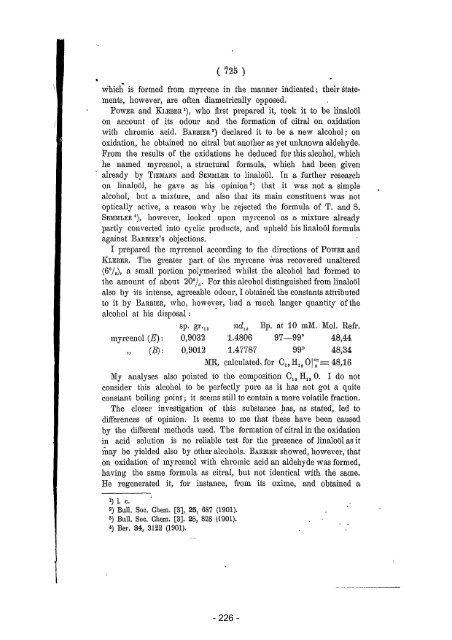Proceedings of the section of sciences - DWC - KNAW
Proceedings of the section of sciences - DWC - KNAW
Proceedings of the section of sciences - DWC - KNAW
You also want an ePaper? Increase the reach of your titles
YUMPU automatically turns print PDFs into web optimized ePapers that Google loves.
( 725 )<br />
",hiel; is formed from myrrene in <strong>the</strong> manner i:ó.dicated; <strong>the</strong>ir Statements,<br />
however, are <strong>of</strong> ten diametrically opposed.<br />
POWER and KUiJBIm 1), who fiTst prepared it, took it to be linaloäl<br />
on account <strong>of</strong> its odour and <strong>the</strong> formation <strong>of</strong> citral on oxidation<br />
with chromic acid. BARBIER 2) declared it to be a new alcohol; on<br />
oxidation, he obttLined no citral but anotlter as yet unknown aldehyde.<br />
From <strong>the</strong> results <strong>of</strong> <strong>the</strong> oxidations he deduced for this alcohol, which<br />
he named myrcenol, a structural formula, which had been given<br />
- already by TIEMANN and SEMMLER to linaloäl. Tn a fur<strong>the</strong>r research<br />
on linaloöl, he gave as his opinion 3) that it was not a simple<br />
alcohol, but a mixture, and also that its main constituent was not<br />
optically active, a reason why he l'ejected <strong>the</strong> formula <strong>of</strong> T. and S.<br />
SEMMLER 4), however, looked upon myrcenol as a, mixture all'early<br />
partly convel'ted into cyclic prodncts, and upheld hislinaloöl formula<br />
against BARBIER'S objections.<br />
I prepared <strong>the</strong> myrcenol according to <strong>the</strong> directions <strong>of</strong> POWER and<br />
KLEBER. 'fhe greater part <strong>of</strong> <strong>the</strong> myrcene ,vas recO\'ered unaltered<br />
(6%)' a 8111a11 portion polymerised whilst <strong>the</strong> alcohol had formed to<br />
<strong>the</strong> amount <strong>of</strong> about 20%, For th is alcohol distinguished from linaloäl<br />
also by Us intense, agreeable odour, I obtained <strong>the</strong> constants attributed<br />
to it by BARBIER, who, however, had a much langer quantity <strong>of</strong><strong>the</strong><br />
alcohol at his disposal: .<br />
myrcenol (E) :<br />
"<br />
(B) :<br />
sp. gr' 15<br />
0,9032<br />
0,9012<br />
MR,<br />
ncl 15<br />
1.4806<br />
1.47787<br />
- 226 -<br />
Ep. at 10 mM. Mol. Refl'.<br />
97 _99 0<br />
48,44<br />
99° 48,34<br />
My analyses also pointed to <strong>the</strong> composition C 10 HlS 0. I do not<br />
consider this alcohol to be perfectly pure as it has not got a quite<br />
constant boiling point; it seems still to contain a mote volatile fraction.<br />
The closer investigation <strong>of</strong> this substance !las, as stated, led to<br />
differences <strong>of</strong> opjnion. It seems to me that <strong>the</strong>se have been caused<br />
by <strong>the</strong> different methads used. The formation <strong>of</strong> citral in <strong>the</strong> oxidation<br />
in acid solution is na reliable test for <strong>the</strong> pt'esence <strong>of</strong> linaloöl as it<br />
inay be yielded also by o<strong>the</strong>r alcohols. BARBIER showed, howevel', that<br />
on oxidation <strong>of</strong> myrcenol with chromic acid an aldehyde was formed,<br />
having <strong>the</strong> same fOl'mula as citl'al, but not identical with <strong>the</strong> same.<br />
He regenerated it, for instance, ti'om its oxime. and obtained a<br />
1) 1. c.<br />
2) BuU. Soc. Chem. [3], 25, 687 (1901).<br />
3) Bull. Soc. Chem. [3]. 25, 828 (·1901).<br />
4) Bel'. 34, 3122 (1901).

















